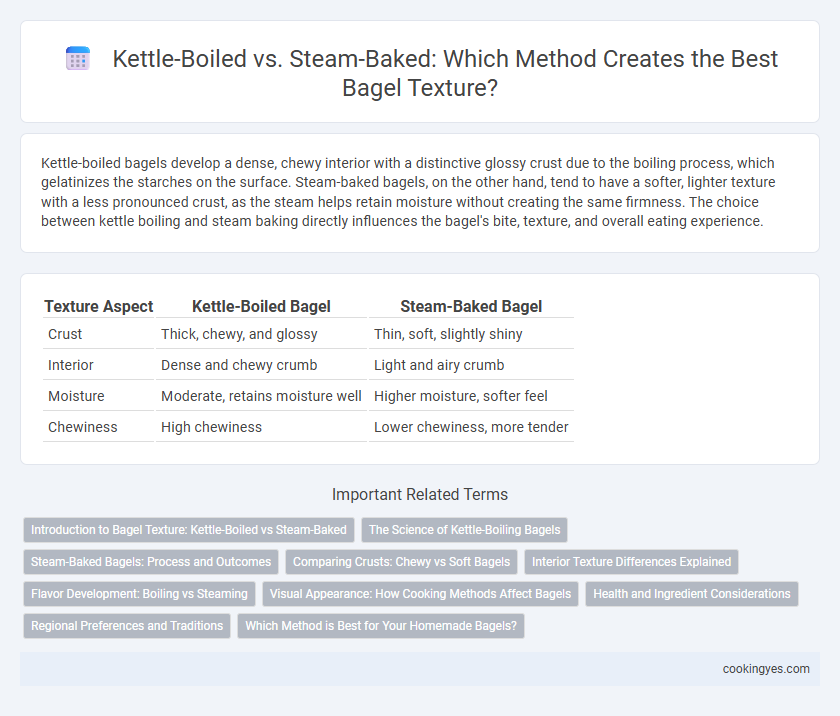Kettle-boiled bagels develop a dense, chewy interior with a distinctive glossy crust due to the boiling process, which gelatinizes the starches on the surface. Steam-baked bagels, on the other hand, tend to have a softer, lighter texture with a less pronounced crust, as the steam helps retain moisture without creating the same firmness. The choice between kettle boiling and steam baking directly influences the bagel's bite, texture, and overall eating experience.
Table of Comparison
| Texture Aspect | Kettle-Boiled Bagel | Steam-Baked Bagel |
|---|---|---|
| Crust | Thick, chewy, and glossy | Thin, soft, slightly shiny |
| Interior | Dense and chewy crumb | Light and airy crumb |
| Moisture | Moderate, retains moisture well | Higher moisture, softer feel |
| Chewiness | High chewiness | Lower chewiness, more tender |
Introduction to Bagel Texture: Kettle-Boiled vs Steam-Baked
Kettle-boiled bagels develop a dense, chewy texture due to brief boiling in water before baking, which sets the crust and creates a glossy, firm exterior. In contrast, steam-baked bagels rely on moisture in the oven to produce a softer, lighter crumb with a tender crust. The choice between kettle boiling and steam baking significantly impacts the bagel's traditional chewiness and crust thickness.
The Science of Kettle-Boiling Bagels
Kettle-boiling bagels involves briefly boiling the dough in water, often with added ingredients like malt syrup or baking soda, which gelatinizes the starch on the surface and creates a distinct chewy crust. This process also traps moisture inside, resulting in the bagel's characteristic dense and glossy texture, while steam-baking lacks this initial starch gelatinization, producing a softer and less chewy crumb. Scientific studies confirm that kettle boiling enhances crust elasticity and crust thickness through Maillard reaction precursors, which are critical for the traditional bagel texture.
Steam-Baked Bagels: Process and Outcomes
Steam-baked bagels undergo a baking process where steam is introduced into the oven, creating a moist environment that results in a softer crust and chewier interior compared to kettle-boiled varieties. This method enhances the bagel's golden color and glossy surface without compromising its dense texture, appealing to those who prefer a less crispy crust. Steam-baked bagels maintain a distinct elasticity and subtle sweetness, distinguishing them from the traditional kettle-boiled bagels which are denser and have a firmer bite.
Comparing Crusts: Chewy vs Soft Bagels
Kettle-boiled bagels develop a dense, chewy crust due to boiling in water before baking, which gelatinizes the starches and creates a glossy exterior. Steam-baked bagels, in contrast, have a softer, less chewy crust as steam introduces moisture during baking, preventing the crust from hardening significantly. The choice between these methods impacts the bagel's texture distinctly, with kettle boiling favored for traditional, chewy bagels and steam baking preferred for softer varieties.
Interior Texture Differences Explained
Kettle-boiled bagels have a dense, chewy interior due to the brief boiling process that gelatinizes the starches, creating a signature firm crumb. Steam-baked bagels feature a softer, more airy interior as steam traps moisture, preventing the crust from becoming too hard and allowing the dough to expand more freely. These differences in hydration and heat application directly impact the bagel's texture, making kettle-boiled varieties notably denser while steam-baked ones remain light and tender inside.
Flavor Development: Boiling vs Steaming
Kettle-boiled bagels develop a distinctively chewy crust and complex flavor through caramelization and Maillard reactions triggered by boiling in water typically infused with malt, honey, or baking soda. Steam-baked bagels, while softer and lighter, lack the intense caramelized crust, resulting in a milder taste and less pronounced chewiness. The boiling process enhances the bagel's surface texture and flavor depth, making kettle-boiled bagels more robust and savory compared to their steam-baked counterparts.
Visual Appearance: How Cooking Methods Affect Bagels
Kettle-boiled bagels feature a shiny, dense crust due to the quick gelatinization of starches on the surface during boiling, creating a distinctive crackled appearance. Steam-baked bagels exhibit a softer, less glossy exterior with a smoother texture, as the steam environment allows for more even moisture retention and gentle crust formation. The choice between boiling and steaming directly impacts the bagel's visual appeal, influencing its traditional look and perceived freshness.
Health and Ingredient Considerations
Kettle-boiled bagels achieve a denser, chewier texture by briefly boiling dough in water often containing malt or baking soda, which can reduce acrylamide levels and create a glossier crust, while steam-baked bagels tend to be softer with a lighter crumb but may lack that characteristic chewiness. Health-wise, kettle boiling helps minimize harmful compounds formed during baking, making it a preferred method for those concerned about food safety and ingredient quality. Ingredient-wise, the water bath can affect nutrient retention and may allow for cleaner labels due to fewer additives compared to steam-baking techniques.
Regional Preferences and Traditions
Kettle-boiled bagels, a hallmark of New York-style bagels, deliver a dense, chewy texture highly prized in Northeastern United States. Steam-baked bagels, prevalent in Montreal, Canada, have a lighter, slightly crispier crust due to their unique preparation method that involves steaming instead of boiling. These regional techniques reflect local traditions and cultural preferences that significantly influence the authentic bagel experience.
Which Method is Best for Your Homemade Bagels?
Kettle-boiled bagels achieve a dense, chewy texture with a shiny, thick crust by briefly boiling dough in water often infused with malt or baking soda. Steam-baked bagels, in contrast, develop a softer crust and less chewy interior due to moisture trapped in the oven, resembling traditional bread more than classic bagels. For authentic homemade bagels, kettle boiling remains the best method to capture the signature chewy bite and characteristic crust prized by bagel enthusiasts.
Kettle-Boiled vs Steam-Baked for Bagel Texture Infographic

 cookingyes.com
cookingyes.com